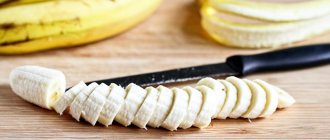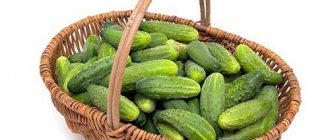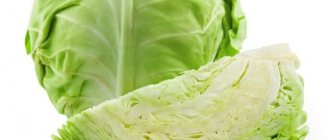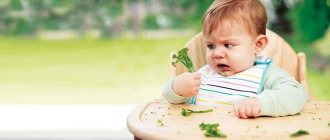Mushrooms are not only a healthy product, but also very tasty. They are consumed as an independent dish and added to many dishes. Mushroom soup is a favorite first course for many adults.
When it comes to baby food, mothers usually treat mushrooms with caution, and there is a healthy grain in this. But you shouldn’t forget about the possible benefits of mushrooms for a child’s body.
Today we will tell you how to prepare mushroom soup for a child that is tasty and healthy, avoiding the pitfalls of this product.
The benefits of pureed mushroom soup for a child
Mushrooms are a valuable product with a rich and varied composition of nutrients. Here are vitamins - B1, B2, A, PP, C, and a number of microelements - calcium, potassium, phosphorus, and enzymes - amylase and lipase
, and most importantly, protein, thanks to which many equate mushrooms with meat.
Important!
On the other hand, mushrooms tend to absorb all the poisonous and toxic substances that are in the surrounding space. Therefore, the safest mushrooms will be those grown in greenhouses - champignons and oyster mushrooms. Although they are not as rich in composition as wild mushrooms, they are much more likely to be easily accepted by the child’s body.
What is healthy about mushrooms?
First of all, they have excellent nutritional properties. In terms of protein content, they can be compared to meat. Mushrooms are sometimes called "forest meat".
Mineral composition:
- potassium;
- magnesium;
- zinc;
- vitamins A, C;
- a lot of phosphorus and potassium, even more than in vegetables and fruits;
- oleic and stearic acids (allow you to fight infectious diseases and strengthen the immune defense).
Mushrooms also contain the substance chitin. By the way, chitin is part of the shells and shells of crustaceans. Just imagine how difficult it is to digest such a product, especially for a child’s body.
How to cook and when is the best time to give mushroom soup to a child?
- Mushroom soup can be introduced into children's diets from the age of three.
This should be done carefully, give it little by little and carefully monitor the baby’s reaction. - For the first try of mushroom soup, it is better to use greenhouse mushrooms.
- To improve the perception of mushrooms by the children's body, they are usually pureed for children and mushroom cream soup is prepared. This treatment partially destroys chitin, which is found in abundance in mushrooms, which improves the absorption of this product.
- Also, some advise introducing your baby to mushrooms not directly, but gradually - first prepare mushroom broth, from which you can then cook regular soup. And then, if there is a good reaction to such a dish, you can give a full-fledged mushroom soup.
Benefits of forest gifts
Why are mushrooms so attractive and useful?
- This is a low-calorie product that is ideal for a diet. The high protein content has allowed mushrooms to be one of the main components of the vegetarian diet.
- Lecithin removes cholesterol from the body and prevents its accumulation. The product is useful for use in cases of impaired metabolism, urolithiasis and cardiovascular problems.
- Mushrooms are considered an excellent prevention of hypertension, they are effective in the treatment of obesity and diabetes, atherosclerosis and heart disease.
- Beta-glucans of the product strengthen the immune system, increasing the regenerative functions of the body.
- Most types of mushrooms contain ergothioneine. This is a powerful natural antioxidant that prevents the occurrence of cancer and helps alleviate the condition in the presence of tumors.
Recipe for baby mushroom soup
Using our recipe, you can easily and quickly prepare a delicious mushroom cream soup from champignons. In the same way, you can prepare puree soup from porcini or dried mushrooms.
Required Ingredients
- onion – 1 pc.;
- butter – 1 tbsp. l.;
- wheat flour – 2 tbsp. l.;
- hot water – 1 tbsp.;
- whole cow's milk - 2 tbsp.;
- fresh champignons (or porcini mushrooms) – 250 g or 150 g of dried mushrooms;
- salt and spices to taste.
Cooking sequence
- Take an onion, peel it and rinse it in cold water, chop it finely.
- Sort the mushrooms thoroughly, peel and wash. If you use dried mushrooms, pre-soak them for 4-6 hours in cold water, drain and rinse.
- Cut the mushrooms into small pieces, you can grate them.
- Place a piece of butter in the pan in which you will cook the soup and put it on the fire. When the butter melts, add the chopped onion and sauté until soft.
- Then add the flour, simmer it together with the onion (it should become a nice golden color) and turn off the heat.
- Add milk and spices and return pan to heat.
- Beat this mass with a mixer, gradually adding the remaining water.
- When the soup boils, cook it for a few minutes over low heat, then add the mushrooms and cook for another 15 minutes.
- Turn off the stove and puree the soup using an immersion blender.
- Add salt before serving.
Mushroom puree soup with cream (you need to add it a few minutes before cooking), herbs (parsley or dill) and homemade croutons turns out very tasty.
After a year, the child’s diet expands greatly. Growing up, the baby no longer just needs nourishing and nutritious food, but also varied food. When trying to introduce new products, it is worth finding out at what age you can give them to your child, in case they cause him harm.
Many people cook various soups from borscht to kharcho. One of many people’s favorite soups is mushroom soup. When can children be given mushroom soup, because it is famous for its high protein content and in vegetarianism replaces meat broth.
Mushrooms are very rich in various substances in their composition. They contain compounds beneficial to the body:
- Vitamins A, B1, B2, C, PP.
- Microelements: potassium, necessary for the stable functioning of the heart muscle, and calcium, an important “building block” for the formation of the skeletal system and baby teeth.
- Phosphorus is a necessary element for the development of brain activity. In terms of its quantity, mushrooms are close to fish products.
- There is so much protein that sometimes an analogy is drawn between mushrooms and meat.
- Enzymes - lipase and amylase.
However, mushrooms also contain chitin, which makes them a difficult food to digest. Chitin is the main component of the shells of snails, crayfish and crabs. It’s hard to imagine that our stomach could digest this, much less a child.
The structure of mushrooms resembles a sponge; they absorb harmful substances from the soil and environment. The environmental situation in many areas of the country leaves much to be desired, so it is worth introducing mushrooms grown in greenhouses: champignons or oyster mushrooms into your child’s menu. For forest mushrooms, you need to clearly know in which area they were collected, what the distance was from roads and railways.
When can you introduce your child to the taste of mushroom soup?
On the question of when you can start feeding children mushroom dishes, in particular soup, the opinions of experts differ somewhat. Some consider it quite possible to consume mushroom soup from the age of three, while others do not recommend introducing mushroom dishes into the menu until the age of six or seven.
The frequency of mushroom soup appearing on a child’s menu should be small. Mushroom soup prepared from high-quality, proven products can be given to children once every two to three weeks. It is better to start with a puree soup made from mushroom broth. The mushroom decoction should be diluted with water and based on it, cook the baby’s usual vegetable soup.
- Complementary feeding: beginning
- Broth soup
- Pea soup
Experts say that mushroom soup can be offered to a child for the first time at the age of 7-8 years. It is better if the mushrooms used are champignons, and the soup is vegetable in a diluted mushroom broth. After all, mushroom dishes are considered “difficult” to digest.
Pediatricians quite often report evidence of mushroom poisoning in preschool children, and it’s not even a matter of their toxicity. It is possible to talk about the final formation of a child’s digestive system by the age of eight, and even at this age it is very difficult for a child’s body to resist various types of intoxication.
At what age can mushroom soup be given?
Many pediatricians agree that it is best to start introducing mushroom soup to children at age 5. By this time, the digestive system completes its formation. It is better to cook soup from champignons.
First, the mushrooms need to be washed under running water, then boiled for 30-40 minutes. You can add chopped potatoes, carrots, and onions. Sautéing in oil is not recommended.
Says Dr. Komarovsky: “Of course, a growing body needs protein as a building material for muscles. I am not against introducing mushroom dishes into the diet of children, but I do not recommend introducing them to children under one year old. Some mothers manage to give mushrooms as first complementary foods, which is absolutely not allowed. Start from the age of 3 gradually, with oyster mushrooms or champignons, in the form of broths, sauces, and then you can be allowed to give a full-fledged mushroom soup, and then your child will not face digestive problems.”
Mushrooms in children's diets: pros and cons
It is difficult to dispute the benefits of mushrooms, because they really are a source of vegetable protein, fiber, valuable vitamins and microelements. Potassium, calcium, phosphorus, iron, magnesium, sodium - this is not the entire list of useful substances found in mushrooms. In terms of the quantity and quality of the minerals that make up mushrooms, scientists equate them to fruits; protein allows mushrooms to replace meat in nutritional value, and carbohydrates to replace vegetables. Substances such as beta-glucans and melanin have a positive effect on the immune system and prevent the occurrence of malignant tumors.
However, to get to the valuable composition of mushrooms, the digestive system has to work hard. The difficulty in assimilating this product lies in the presence of a substance – fungin. The chemical composition of fungin is similar to chitin, which is part of the shell of crayfish, crabs, snails and some insects. Such a task is sometimes beyond the capabilities of even an adult body, and preschool children do not have enough enzymes in their stomachs necessary for this. Dietary fiber from mushrooms also has a coarse structure, which makes it difficult for children to absorb them.
In addition, the spongy structure of mushrooms is often the texture that absorbs toxins from the environment. Alas, the state of forests today leaves much to be desired. Even if parents decide to feed their child mushroom soup, it is better to cook it not from forest representatives, but from greenhouse champignons or oyster mushrooms.
Mushroom poisoning
There is always a risk of mushroom poisoning for a child, especially a small one. The danger exists both when consuming fresh and canned foods. Even completely harmless for an adult, they can be poisonous for a baby, whose body is hypersensitive to toxins. Some products enhance their toxic effect. For example, it is not recommended to drink sour juice, as acid increases toxicity.
The first signs of mushroom poisoning are a metallic taste in the mouth, nausea, severe vomiting, diarrhea, and abdominal pain. In severe poisoning, convulsions, hallucinations appear, and constriction of the pupils occurs. If you suspect poisoning, you must call an ambulance.
Before the ambulance arrives, the child is given gastric lavage, an enema, and given activated charcoal to drink. Emergency doctors need to accurately explain the cause of poisoning so that assistance can be provided most effectively.
Video: Forest mushroom poisoning
Advice:
The systematic inclusion of mushrooms in a child’s food can lead to gastritis. Children are unlikely to be able to appreciate the taste characteristics of mushroom dishes, and it is much easier to get nutrients from other foods (meat, fish, vegetables and fruits). At least until the age of 7 (by this age the formation of the digestive system ends), and even better, it is advisable not to give mushrooms until the age of 10.
Reading time for this article: 10 min.
Mushroom soup and potatoes with mushrooms can be safely called, if not traditional dishes of Russian cuisine, then certainly folk delicacies. Many parents and their children are not averse to going on a “quiet hunt” on a summer or autumn day. But is it possible to treat ourselves to “booty” together? The question is complex, but extremely important, so let’s try to answer it.
Where to begin
The optimal age when you can feed your child mushroom soup is 7-8 years. Some parents, at their own risk, start at the age of five, but in this case, under no circumstances should you offer soup cooked for the whole family. The first mushroom soup in a baby’s life should not contain mushrooms themselves, but only their broth with a set of vegetables familiar to him. This can be a puree soup, and to prepare it, the mushroom broth must be diluted by half with water. The mushroom aroma is so strong that it will certainly attract the child's attention to the new dish.
Gradually, you can introduce chopped mushrooms into the children's diet, but nutritionists recommend adding cream to mushroom soup. They will make the first dish more delicate in taste and make it easier to digest. It must be said that not all mushrooms are suitable for baby food. It would be better to start with champignons, since they do not contain toxins and are considered easier to digest. It is important not to rush things and offer the child a small portion for the first time, observing his reaction. Even if everything is in order, it is not recommended to give mushroom soup to children more than once every 2 to 3 weeks.
- Mushroom soup for children
- At what age can children be given mushroom soup?
At what age can a child have mushroom soup?
Julia asks: “Hello. My son is 2.6 years old (not allergic). Is it possible to give light mushroom soup at this age?
There is no consensus on the timing of introducing mushrooms into children's diets. According to some experts, they are approved for use from the age of 3. Others claim that only from 5-7 years of age, or even from 10 years.
The reason for the disagreement is explained by the composition of the product, which is undoubtedly beneficial and nutritious for the child’s body. Mushrooms contain a lot of vegetable protein (which allows us to call them “vegetable meat”), vitamins PP, A, group B, ascorbic acid and minerals necessary during the growth period (calcium, phosphorus, potassium).
On the other hand, they contain chitin and fiber, which are practically not digested and cause digestive problems even in adults. But the main thing is that mushrooms grow quickly and, like a sponge, absorb all the environmental “garbage” from the environment.
In six months, your baby will reach the acceptable age limit for preparing children's dishes with mushrooms. Take your time, as other products offer the same benefits without putting as much strain on your digestive system.
The first acquaintance, as you wrote, is better to start with a light soup. More precisely, cooked in a decoction diluted with water, but without the mushrooms themselves. Using the broth as a basis, you can also offer your child a sauce for the main dishes.
A few tips will help you avoid mistakes in selection and preparation:
- Buy mushrooms grown in artificial conditions. While their range is small, but safe: champignons and oyster mushrooms.
- Use mushroom caps to prepare children's dishes. They have more nutritional value, less chitin and mushroom threads.
- Before cooking, oyster mushrooms and champignons should be finely chopped if they are intended for feeding a child. This way you will also chop the mushroom threads, which give the product density.
- Children digest and absorb pureed soups more easily.
- Mushrooms should be a rare guest on the menu. It will be enough to treat your child to soup 2 times a month.
Do not buy oyster mushrooms and champignons from private individuals or in spontaneous markets, since it is almost impossible to obtain reliable information about the conditions for their cultivation.
Do not risk your baby's health by offering him mushrooms grown in the natural environment. Even confident experts on edible mushrooms can make mistakes.
After a year, the child’s diet expands greatly. Growing up, the baby no longer just needs nourishing and nutritious food, but also varied food. When trying to introduce new products, it is worth finding out at what age you can give them to your child, in case they cause him harm.
Many people cook various soups from borscht to kharcho. One of many people’s favorite soups is mushroom soup. When can children be given mushroom soup, because it is famous for its high protein content and in vegetarianism replaces meat broth.
Cooking and eating mushrooms
- Children are not recommended to eat mushrooms more than once a week. It’s better to reduce the frequency to once or twice a month. The daily norm of the product is 50-60 grams;
- Give preference to products grown in artificial conditions. Champignons are considered the safest because they are easier to digest than other types. The second safest are oyster mushrooms;
- Among the forest species, you can eat chanterelles and porcini mushrooms, but it is important to use only edible species, since poisonous analogues can be found in the forest! In addition, such products absorb heavy metals well, are difficult and take a long time to be absorbed in the body;
- Forest mushrooms should be collected only in ecologically clean areas, away from roads and highways, plants and factories. Give preference to fresh young fruits when cooking; sometimes you can use dried ones;
- Before cooking, wild mushrooms are boiled at least three times for 15 minutes. This will eliminate the chemicals they have absorbed from the soil or air;
- Before cooking, any types of mushrooms are carefully sorted, cleaned and washed. At first, it is better to grind the product to a mushy mass, as it is easier to chew and digest. Then gradually work your way down to finely chopped pieces;
- Children should not be given fried, salted or pickled, canned, raw or half-raw mushrooms!
Composition of mushrooms: benefits and harms
Mushrooms are very rich in various substances in their composition. They contain compounds beneficial to the body:
- Vitamins A, B1, B2, C, PP.
- Microelements: potassium, necessary for the stable functioning of the heart muscle, and calcium, an important “building block” for the formation of the skeletal system and baby teeth.
- Phosphorus is a necessary element for the development of brain activity. In terms of its quantity, mushrooms are close to fish products.
- There is so much protein that sometimes an analogy is drawn between mushrooms and meat.
- Enzymes - lipase and amylase.
However, mushrooms also contain chitin, which makes them a difficult food to digest. Chitin is the main component of the shells of snails, crayfish and crabs. It’s hard to imagine that our stomach could digest this, much less a child.
Note to moms!
Hello girls) I didn’t think that the problem of stretch marks would affect me too, and I’ll also write about it))) But there’s nowhere to go, so I’m writing here: How did I get rid of stretch marks after childbirth? I will be very glad if my method helps you too...
The structure of mushrooms resembles a sponge; they absorb harmful substances from the soil and environment. The environmental situation in many areas of the country leaves much to be desired, so it is worth introducing mushrooms grown in greenhouses: champignons or oyster mushrooms into your child’s menu. For forest mushrooms, you need to clearly know in which area they were collected, what the distance was from roads and railways.
When can you introduce your child to the taste of mushroom soup?
On the question of when you can start feeding children mushroom dishes, in particular soup, the opinions of experts differ somewhat. Some consider it quite possible to consume mushroom soup from the age of three, while others do not recommend introducing mushroom dishes into the menu until the age of six or seven.
The frequency of mushroom soup appearing on a child’s menu should be small. Mushroom soup prepared from high-quality, proven products can be given to children once every two to three weeks. It is better to start with a puree soup made from mushroom broth. The mushroom decoction should be diluted with water and based on it, cook the baby’s usual vegetable soup.
Many adults like dishes with mushrooms, but when a child appears in the family, mothers often hesitate to cook mushroom soup or potatoes with mushrooms for the family, knowing that the baby will probably want to try such food. Opinions about the age of including mushrooms in children's diets differ among both parents and doctors. And if almost everyone has a rather wary attitude towards wild mushrooms, then there is debate about the possibility of children consuming champignons.
Some argue that these mushrooms are much easier to digest than forest mushrooms and can easily be included in children’s menus if you choose and prepare them correctly. Others are sure that children do not need any mushrooms, not even champignons. Let's figure out when you can prepare a dish with champignons for your baby and whether such mushrooms are healthy for children.
What are the harms of mushrooms?
Parents have the right to decide for themselves at what age to give mushrooms to their child. Only in this case should one take into account their harmful effects on the baby’s body:
- Chitin interferes with the absorption of nutrients. In addition, it may enhance the allergic effects of other products.
- It's easy to get poisoned by mushrooms. Many of them have extremely poisonous counterparts: false honey mushrooms, false white (the so-called satanic). Therefore, feeding a child mushrooms that you have collected yourself is especially dangerous.
- The body of mushrooms has a porous structure, so they, like a sponge, absorb harmful substances from soil and dust, which significantly increases their toxicity.
Before preparing dishes, it is recommended to boil wild mushrooms 3 times for 15 minutes, draining the water. This helps get rid of the chemicals they have absorbed. But poisons are not destroyed by heat treatment. But the nutritional value after such boiling is significantly reduced.
Benefits of mushrooms
Due to possible problems with absorption, many adults classify mushrooms as a useless food that should not be offered to children at all. However, quality mushrooms have quite high nutritional value. They provide the human body with vegetable proteins, fiber, vitamins C, PP, D, A, group B, calcium, easily digestible fats, potassium, phosphorus and many other compounds. In addition, champignons are a source of enzymes and organic acids.
It should be noted that most of the beneficial substances in mushrooms are concentrated in their caps, and chitin, which is harmful to the child’s body, is more present in the legs. For this reason, only mushroom caps are suitable for baby food.
What are the benefits of mushrooms?
Mushrooms are sources of vitamins A, C, PP of group B. They contain many valuable microelements: calcium, sodium, iron, potassium, phosphorus and others. They are rich in proteins, fats, carbohydrates, amino acids. There are substances necessary to enhance immunity and improve metabolism. Most of the nutrients are in the caps. The legs have virtually no nutritional value. In addition, they contain chitin, a rough fiber that is not digested in the human stomach.
Note:
Chicken egg protein is absorbed in the body by 99%, the protein contained in beef is 75%, and mushroom protein is only 3%. Therefore, in order to get enough protein, you need to eat so many of them that it can lead to poisoning.
Why are mushrooms harmful?
Restrictions on the consumption of mushrooms in childhood are associated not only with the content of chitin in such a product, which is not digested and interferes with the absorption of other nutrients. Forest mushrooms absorb many substances from the soil, including dangerous ones.
But, if we are talking about champignons purchased in a store, such a shortage of mushrooms is excluded. For this reason, the inclusion of champignons in the diet of children is permissible somewhat earlier than mushrooms collected in the forest.
More information about the benefits and harms of champignons is described in the video:
Types of mushrooms
Mushrooms are divided into forest and grown in an artificial environment. Forest mushrooms are milk mushrooms, honey mushrooms, boletus mushrooms, saffron milk caps, porcini mushrooms. These types of mushrooms ripen in natural conditions, in the grass, in the sun. Of course, such mushrooms are much healthier.
Mushrooms that are grown artificially are the most common type: champignons, oyster mushrooms. The taste, of course, cannot be compared with milk mushrooms or chanterelles, but you don’t have to worry about their purity, since they undergo full quality control.
At what age should it be given?
Some doctors do not recommend giving any mushrooms to children under 10-14 years of age, but many pediatricians, including Evgeny Komarovsky, believe that champignons can be tried from the age of 2. What all doctors are unanimous about is that it is unacceptable to offer champignons to a one-year-old child.
A child who is 2 years old can be given mushrooms that are grown industrially.
At first, they are included in the children's menu in small quantities, for example, as part of a sauce or by adding a few mushrooms to the main dish. Over time, you can prepare peeled and well-cooked pieces of mushrooms for your child. In this case, the frequency of consumption of dishes with champignons for a child under 5 years old (for example, 4 years old) is limited to once a week.
Many doctors recommend delaying exposure to any mushrooms, including champignons, until the age of 7-10 years. They associate this recommendation with the fact that school-age children have a fully developed digestive system, so there will be no problems with digesting mushroom dishes. If a child has any problems with the gastrointestinal tract, introducing mushrooms into his diet before the age of 10 is extremely undesirable.
Mushroom soup in children's diet
Many mothers and fathers ask the question, “Can a one-year-old child have mushroom soup?” Perhaps it’s better to wait a bit with this dish.
Pediatricians recommend starting to get acquainted with mushrooms no earlier than 3 years, and then with extreme caution. And some even suggest postponing dating until school age.
We will give some recommendations regarding the use of mushrooms by children.
The body of a 3-year-old child is not able to cope with the digestion of such rough food, so he can only occasionally be offered vegetable puree soup cooked in mushroom broth.
The optimal frequency for children to consume mushroom soup is once every 2-3 weeks.
In children's menus, it is better to use mushrooms grown under artificial conditions, for example, champignons.
You should add sour cream or cream to mushroom soup; this will make the process of digesting the heavy product easier.
It is better not to offer pickled or salted mushrooms to a child at all until the age of 14.
Subject mushrooms to long-term heat treatment to prevent harmful substances from entering the body.
The reaction of a child’s body to mushroom dishes can be the most unexpected. Often poisoning with this product occurs when consuming the most common edible mushrooms.
Of course, there is no need to panic if the baby accidentally tastes a spoonful of mushroom soup from the parent’s plate, but it is imperative to monitor the body’s reaction to such a delicacy.
Evaluate all the pros and cons of eating mushroom dishes for your child and decide for yourself whether to introduce him to a new dish at three, five or seven years old. Remember that children and their health are your main concern.
For a child over one year old, it is very important to expand the diet. After all, a growing body needs more and more diverse products every day. Today we will talk about mushrooms and at what age they can be given for the first time, in what form and whether a child needs them at all.
How to choose champignons for a children's menu?
Children should only be given mushrooms from the store, since such champignons do not absorb harmful compounds from the soil, like wild ones. Buy small, light-colored mushrooms for baby food. Avoid buying champignons that are darkened, slippery or flabby. You should also not purchase mushrooms that are too large, as they are overripe and contain fewer nutrients.
If you buy packaged mushrooms, carefully study the information on the packaging - the date the champignons were harvested, the date they were packaged, and the expiration date. When you bring the mushrooms home, be sure to remove them from the film and store them in the refrigerator for a maximum of 24 hours. If you are not going to cook anything with them right away, you can put the champignons in the freezer, where they can be stored for up to 1 year.
Where to collect and how to process mushrooms for consumption?
To protect yourself as much as possible from poisoning, you need to know the rules for collecting mushrooms.
Autumn mushrooms are the least toxic, so it is preferable to collect them at this time of year.
You cannot “hunt” near power lines, highways, landfills and other objects that create a negative environmental background.
To collect mushrooms, it is better to choose a place far from the city.
Do not put large mushrooms in the basket, you will not get any benefit from them; give preference to small and dense mushrooms with a small cap and stem without damage.
And, of course, collect only those mushrooms that are familiar to you, and avoid dubious ones.
Processing mushrooms must be done immediately after returning home (no later than 3-4 hours after collection). You need to do this correctly:
- To begin with, they should be washed and peeled from the peel on the cap and stem and the so-called “fringe” under the cap.
- You should not keep mushrooms in water for a long time; the protein compounds will be “washed out” of them (3-5 minutes will be enough).
- But mushrooms that are being prepared for drying should not be soaked at all.
Dishes with champignons for children
Delicious mushrooms such as champignons go well with vegetables, potato or meat dishes. They can be an ingredient in vegetable casseroles, cabbage rolls, omelettes, and soups.
Many adults also love a variety of pastries with mushroom filling, but it is not recommended for children’s menus, since the combination of mushrooms and dough is quite difficult to digest. Offer children pancakes, pizza or champignon pies only from the age of 14.
Cream soup
For this dish, take one onion, one potato and one medium carrot, as well as about 500 g of champignons. The process for preparing the soup will be as follows:
- After pouring 500 ml of water into the pan, place the container on the stove and wait until it boils.
- While the water is heating, peel and chop the vegetables finely, then place them in boiling water.
- After leaving the onions, carrots and potatoes to cook, wash, peel and chop the mushrooms.
- After dipping the champignons into the vegetable broth, simmer the soup until all the ingredients are ready over low heat.
- After removing the pan from the stove, use an immersion blender to puree the soup.
- Salt the finished dish to taste, sprinkle with herbs and season with sour cream. It is delicious served with oven-dried wheat croutons.
Most children like this soup, but it should not be given to a child who has not tried champignons before. Let the baby first get acquainted with mushroom dishes in the form of sauce.
Sauce
The sauce made from champignons allows you to add a new aroma and pleasant taste to the usual dishes of chicken, potatoes or rice. This recipe is suitable for children over three years old:
- Wash, peel and boil 8-12 small champignons in 500 ml of water.
- Cut one peeled onion and lightly fry in a small amount of vegetable oil, then add to the broth.
- Fry a tablespoon of flour in a dry frying pan. When it acquires a golden hue, add salt and, stirring constantly, pour hot mushroom broth into the fried flour.
- Cook the sauce for about 10 minutes, then remove from heat and add 2 tbsp to the dish. spoons of butter. If desired, you can also add chopped herbs to this mushroom sauce.
Useful properties of mushrooms
People have been eating mushrooms for a long time. This healthy and tasty product has a unique chemical composition that is worth considering in more detail. The composition of “forest meat”, beloved by many gourmets, includes:
- protein substances. Actually, it is because of them that the product is considered forest and plant meat. At the same time, mushroom protein is poorly absorbed due to indigestible fiber;
- carbohydrates. They are part of the product, but are practically not digested, again due to the fiber contained in mushrooms;
- fats. These substances are found in significant quantities in saffron milk caps, champignons, and porcini mushrooms—it is these varieties that are most easily absorbed by the child’s body;
- sugary substances. Provide an original pleasant taste;
- resinous substances. Milk mushrooms and volnushki are the most saturated with them - varieties with a sharp, specific taste. They are not recommended for children, especially for their first acquaintance with the product;
- minerals are found in abundance: phosphorus and potassium, magnesium and iron, copper and manganese;
- vitamins: A, D, C, PP and group B. In terms of the amount of vitamins from subgroup B, “forest meat” is superior to cereals. Porcini mushrooms, boletus mushrooms, honey mushrooms, chanterelles and boletuses contain niacin;
- enzymes. Useful components included in edible varieties. They accelerate the breakdown of proteins, fats and carbohydrates. Champignons contain the most enzymes;
- organic acids. Helps strengthen the immune system.
Of particular value are also animal starch glycogen, which is part of the product, lecithin, amino acids, antioxidants and ß-glucans.
| Product | Calorie content kcal. | Squirrels gr. | Fats gr. | Carbohydrates gr. |
| Porcini | 34 | 3,7 | 1,7 | 1,1 |
| boletus | 20 | 2,1 | 0,8 | 1,2 |
| Boletus | 22 | 3,3 | 0,5 | 1,2 |
| Butter | 19,2 | 0,9 | 0,4 | 3,2 |
| Milk mushrooms | 18,5 | 1,8 | 0,8 | 1,1 |
| Champignon | 27 | 4,3 | 1 | 1 |
| Chanterelles | 19 | 1,5 | 1 | 1 |
| Volnushki | 24,5 | 2,5 | 0,75 | 1,7 |
| Saffron milk caps | 22,3 | 1,9 | 0,8 | 2 |
| Oyster mushrooms | 38,89 | 2,98 | 0,96 | 5,36 |
Why can't children eat mushrooms?
Can children be given mushrooms? Any pediatrician will be categorically against introducing this product into the diet of children, especially wild varieties. And the reason for this ban is explained as follows:
- Despite all the usefulness of “forest meat” for adults, the chemical composition of the product is very dangerous for the child’s body. The fact is that mushrooms contain a special stable substance - chitin, which is not absorbed even by an adult organism. This substance interferes with the normal absorption of other nutritional components of the product. By the way, it is chitin that makes up the shells of arthropods. The human stomach is unable to cope with this substance, much less the stomach of a child. Often this element causes intoxication of the child’s body.
- Another good reason for the ban is that mushrooms are essentially a sponge that absorbs a colossal amount of harmful substances from the outside - from the atmosphere and soil. And since our ecology is far from ideal, it’s scary to even imagine what might end up in the body of a baby who has tasted such gifts of nature. And these are heavy metals, pesticides and radionuclides. Moreover, heat treatment does not affect these substances in any way.
- The third and most important reason explaining why children should not eat mushrooms is doubt about their edibility. There are often cases when even the most experienced mushroom pickers made mistakes, which led to tragic consequences. Buying from hand is especially dangerous; in this case, edible and poisonous mushrooms can easily end up in the same basket. Or maybe they were collected along a highway or in an industrial area, where they absorbed all the harmful substances. Therefore, do not risk your health and the health of your children!










